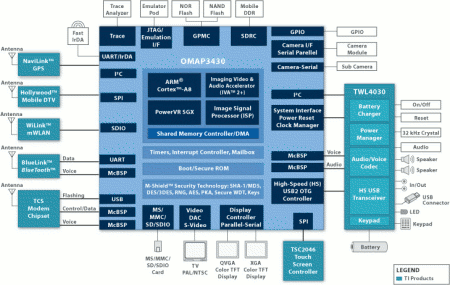3G cellphone reference designs target Linux
Jul 24, 2007 — by LinuxDevices Staff — from the LinuxDevices Archive — 4 viewsEricsson and Texas Instruments (TI) plan to create mobile phone hardware reference designs around Ericsson's 3G baseband processors and TI's ARM-based “OMAP” applications processors. The designs will run “open” OSes such as Linux, and come pre-validated to meet specific operator requirements, the companies claim.
The designs are to include Ericsson baseband processors for HSPA (high-speed packet access) and LTE (long-term evolution) networks. They will also include TI application processors, including models from its ARM11-based OMAP 2 family, and its ARM Cortex A8-based OMAP 3 lines.
According to TI, the OMAP 2 architecture first brought cellphones features such as high-quality digital TV, DVD-quality video, digital cameras up to 6 megapixels, analog and digital broadcast reception, high-speed wireless connectivity, and greater-than-VGA resolution color LCDs. It also supports the company's SmartReflex power and performance management technology.
The new OMAP 3 architecture, introduced in February 2007, is claimed to perform as much as 300 percent faster than its ARM11-based predecessors. An integrated imaging accelerator on the OMAP3430 — first of the line to be sampled — can encode and decode video at DVD resolutions.

OMAP processor roadmap
(Click to enlarge)
TI says the OMAP3430 processor embeds Imagination Technologies' PowerVR SGX graphics core, making it “the first applications processor to support OpenGL ES 2.0 and OpenVG.” The OMAP3430 can reportedly be connected to either a DVD-quality camcorder or a 12 megapixel still camera, with minimal shot-to-shot delay.
TI OMAP3430 diagram, shown connected to a TI baseband processor
(Click to enlarge)
Interestingly, mobile phone stack vendor Access recently promised to deliver OMAP3430 support in its Access Linux Platform product. The OMAP3430 appears to be the first of TI's OMAP 3 line to sample.
The joint EMP/TI designs will support “open” OSes, including Linux, Symbian, and Windows Mobile, the companies said. To ensure compliance with operator requirements, the designs will be subjected to Ericsson's “Mobile Platforms IOT” regimen, described as “one of the industry's most extensive interoperability testing processes.”
Robert Puskaric, head of Ericsson's mobile platforms unit, stated, “EMP's access technology and platform size leadership with TI's innovative OMAP application processors [will] provide the most capable open OS platforms on the market today.”
Handsets based on EMP/TI hardware reference designs are expected to reach market in the second half of 2008.
This article was originally published on LinuxDevices.com and has been donated to the open source community by QuinStreet Inc. Please visit LinuxToday.com for up-to-date news and articles about Linux and open source.
